How to spot harmful emails like I Paid For Products From Your Store
Phishing/ScamAlso Known As: I Paid For Products From Your Store malspam
Get free scan and check if your device is infected.
Remove it nowTo use full-featured product, you have to purchase a license for Combo Cleaner. Seven days free trial available. Combo Cleaner is owned and operated by RCS LT, the parent company of PCRisk.com.
What is "I Paid For Products From Your Store" email virus?
After inspecting this letter, our team concluded that its purpose is to trick recipients into infecting their computers with malware. We found that this email is disguised as a letter regarding a money refund and contains an attachment designed to download a file containing another (malicious) file.
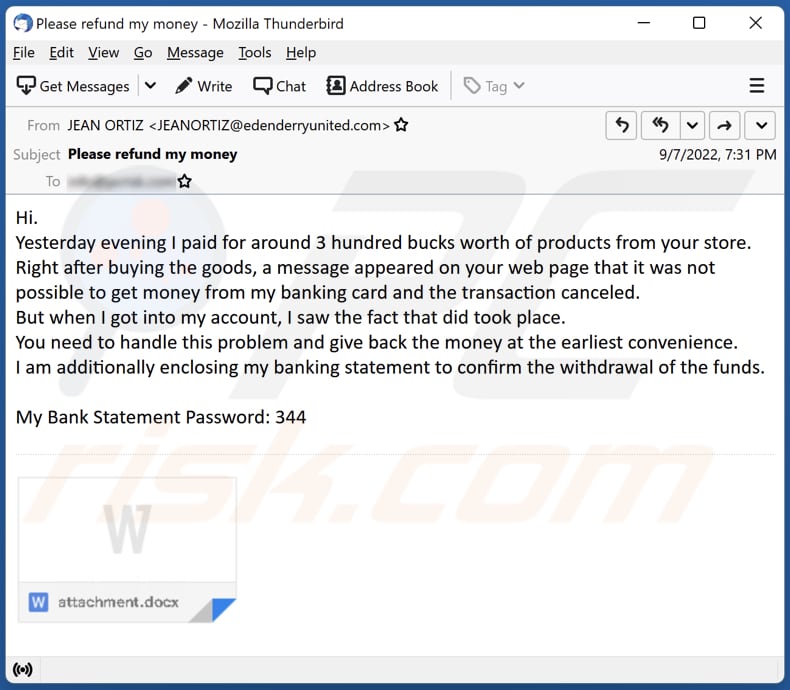
More about the "I Paid For Products From Your Store" email
This email states that someone overpaid ~$300 for products from a store and requests a refund. It says that a message appeared after paying for the goods claiming that money had not been paid. Still, after checking the bank account, the sender/buyer discovered that a transaction has been made. This email also contains some "bank statement password" and an attachment.
The file attached to this email is disguised as a document. However, it is an image with a link inserted into it. Opening that image downloads an archive file containing a malicious file. It is unknown what type of malware is distributed via this email. There is a high chance that threat actors use it to deliver ransomware, cryptocurrency miner, Trojan, or other malware.
The purpose of ransomware is to encrypt files. Encrypted files cannot be opened until they are decrypted. Usually, the attackers are the only ones who can provide a decryption tool. Cryptocurrency miners use computer hardware to mine cryptocurrency. Infected computers consume more electricity, and other problems can occur (e.g., the operating system may constantly crash).
| Name | I Paid For Products From Your Store malspam |
| Threat Type | Trojan, password-stealing virus, banking malware, spyware. |
| Hoax | The sended (buyer) has overpaid for goods |
| Attachment(s) | Image file disguised as MS Word document |
| Detection Names (Archive File) | Alibaba (Trojan:Application/Generic.46cd350f), Baidu (Archive.Bomb), Cyren (ABRisk.ZWUL-6), Kaspersky (HEUR:Trojan.Multi.Generic), Kingsoft (Win32.Troj.ArchiveVir.aa.(kcloud)), Full List Of Detections (VirusTotal) |
| Symptoms | Encrypted files, slow computer performance, lost access to online accounts, unauthorized banking transactions, etc. |
| Payload | Unknown malware |
| Distribution methods | Archive file that downloads from the link insterted in an image file |
| Damage | Stolen passwords and banking information, identity theft, the victim's computer added to a botnet, encrypted data, monetary loss, or other issues. |
| Malware Removal (Windows) |
To eliminate possible malware infections, scan your computer with legitimate antivirus software. Our security researchers recommend using Combo Cleaner. Download Combo CleanerTo use full-featured product, you have to purchase a license for Combo Cleaner. 7 days free trial available. Combo Cleaner is owned and operated by RCS LT, the parent company of PCRisk.com. |
Emails of this type in general
Letters used to spread malware usually look like official/important/urgent letters from real (legitimate) companies. They either contain malicious links or attachments. Threat actors behind such emails attempt to trick recipients into infecting their computers with malware that encrypts files, steals sensitive information, mines cryptocurrency, or performs other malicious activities.
Examples of other emails of this type are "YouTube Copyright Infringement Warning Email Virus", "Declined Debit Email Virus", and "ACHIVA Email Virus".
How did "I Paid For Products From Your Store email virus" infect my computer?
This letter contains a malicious image masquerading as an MS Word document. Opening that image downloads an archive file from an inserted website link. A computer becomes infected after opening a file extracted from the previously-mentioned archive file.
How to avoid installation of malware?
Do not trust irrelevant emails received from suspicious addresses (e.g., emails sent from your or unknown or misspelled address). It is common for such emails to contain malicious attachments or links. Also, avoid using questionable sources for downloading software. Download it from official websites and stores.
Keep the operating system and installed programs up to date. Use functions/tools provided (created) by the official software developers to update and activate them. If you've already opened "I Paid For Products From Your Store email virus" attachment, we recommend running a scan with Combo Cleaner Antivirus for Windows to automatically eliminate infiltrated malware.
Text presented in the "I Paid For Products From Your Store" email:
Subject: Please refund my money
Hi.
Yesterday evening I paid for around 3 hundred bucks worth of products from your store.
Right after buying the goods, a message appeared on your web page that it was not possible to get money from my banking card and the transaction canceled.
But when I got into my account, I saw the fact that did took place.
You need to handle this problem and give back the money at the earliest convenience.
I am additionally enclosing my banking statement to confirm the withdrawal of the funds.My Bank Statement Password: 344
Malicious "Setup" process running in the Task Manager:
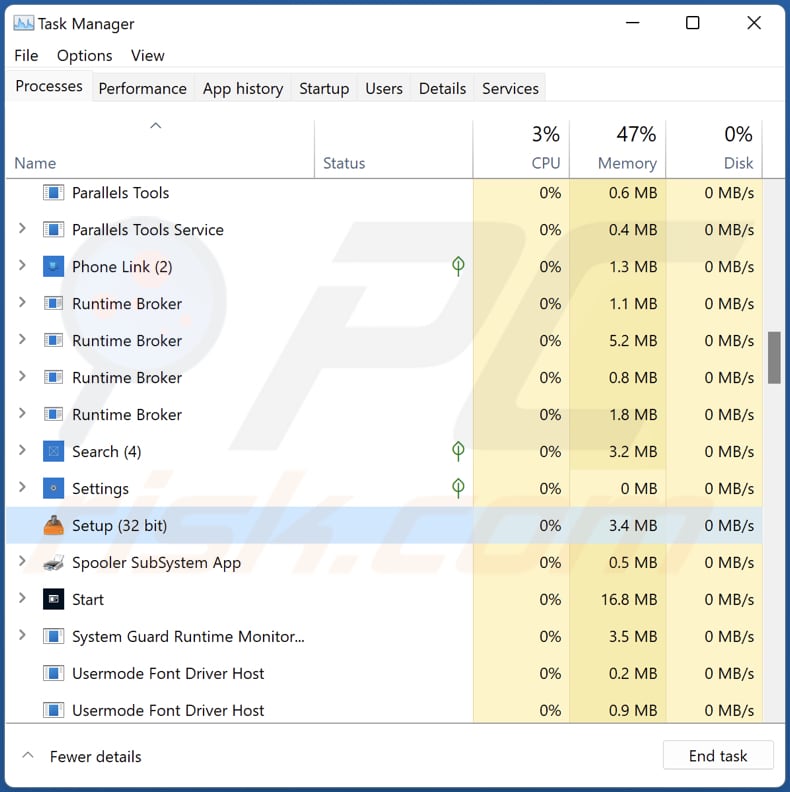
Another example of a spam email from "I Paid For Products From Your Store" campaign:
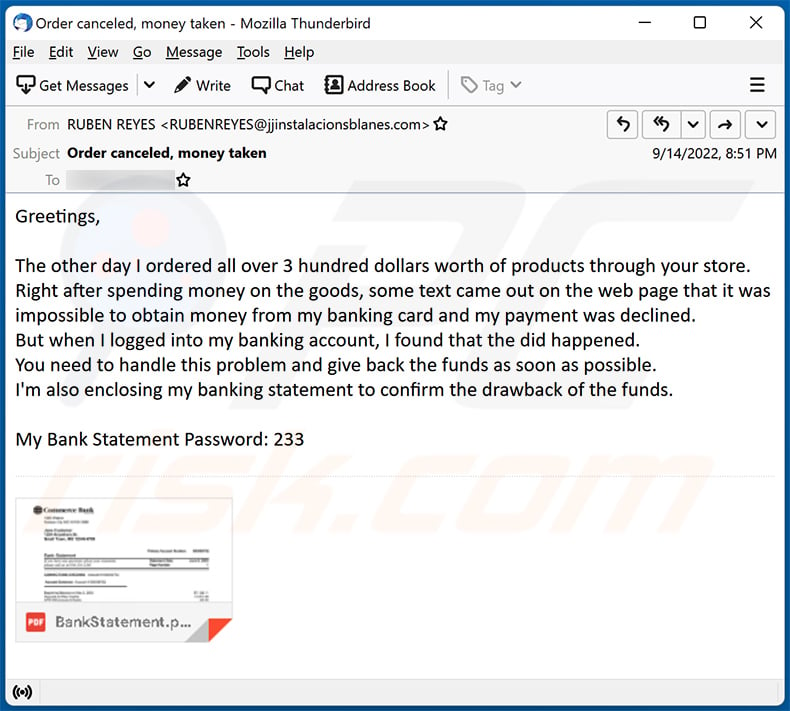
Text presented within:
Subject: Order canceled, money taken
Greetings,The other day I ordered all over 3 hundred dollars worth of products through your store.
Right after spending money on the goods, some text came out on the web page that it was impossible to obtain money from my banking card and my payment was declined.
But when I logged into my banking account, I found that the did happened.
You need to handle this problem and give back the funds as soon as possible.
I'm also enclosing my banking statement to confirm the drawback of the funds.My Bank Statement Password: 233
Yet another example of purchase-themed spam email spreading malware:
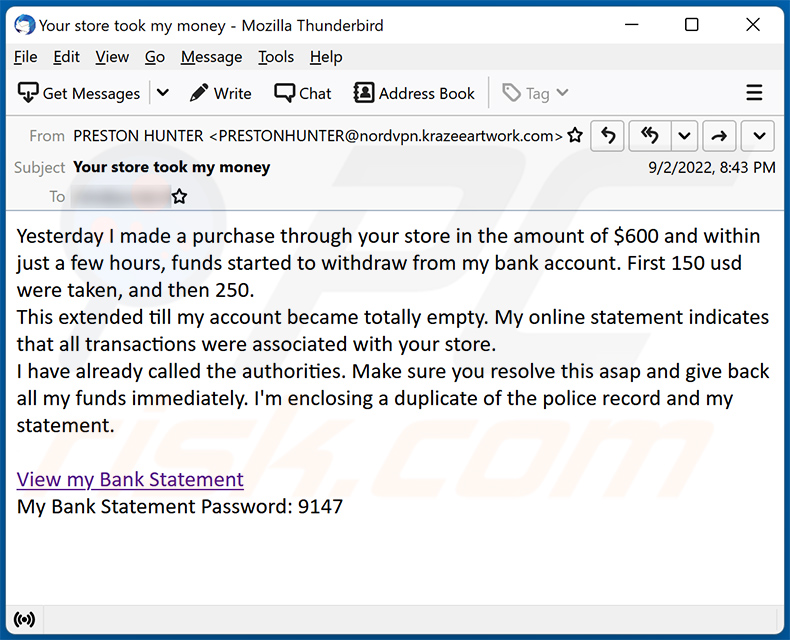
Text presented within:
Subject: Your store took my money
Yesterday I made a purchase through your store in the amount of $600 and within just a few hours, funds started to withdraw from my bank account. First 150 usd were taken, and then 250.
This extended till my account became totally empty. My online statement indicates that all transactions were associated with your store.
I have already called the authorities. Make sure you resolve this asap and give back all my funds immediately. I'm enclosing a duplicate of the police record and my statement.View my Bank Statement
My Bank Statement Password: 9147
Yet another example of a spam email from "I Paid For Products From Your Store" spam campaign:
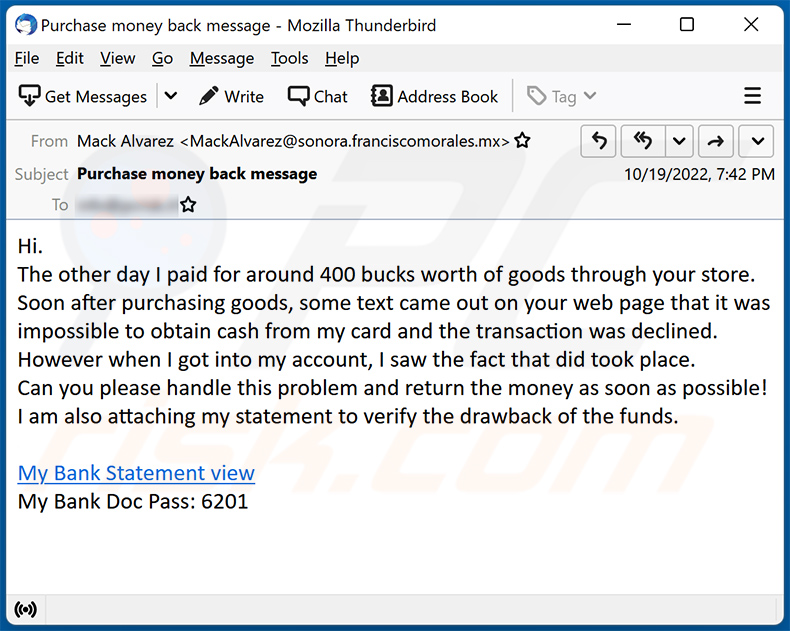
Text presented within:
Subject: Purchase money back message
Hi.
The other day I paid for around 400 bucks worth of goods through your store.
Soon after purchasing goods, some text came out on your web page that it was impossible to obtain cash from my card and the transaction was declined.
However when I got into my account, I saw the fact that did took place.
Can you please handle this problem and return the money as soon as possible!
I am also attaching my statement to verify the drawback of the funds.My Bank Statement view
My Bank Doc Pass: 6201
Yet another example of an email from "I Paid For Products From Your Store" spam campaign:
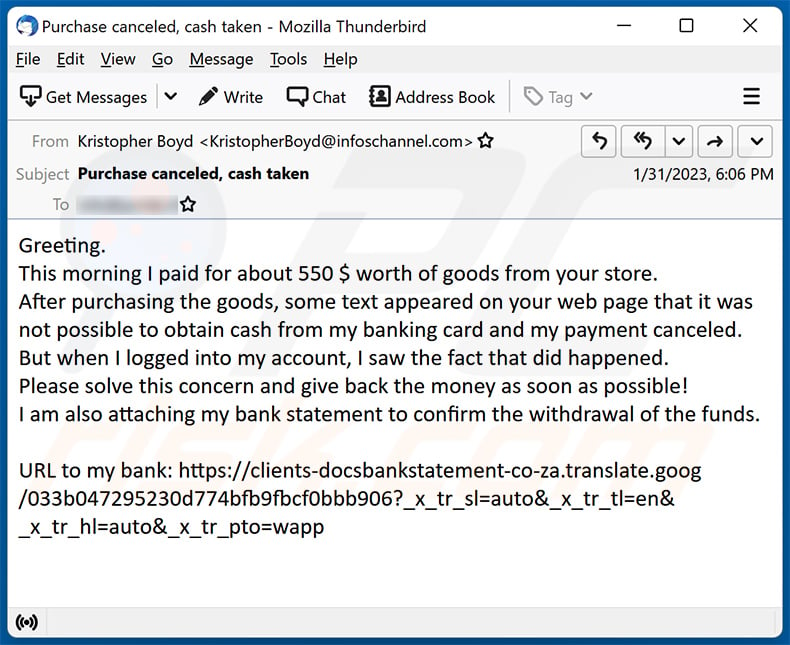
Text presented within:
Subject: Purchase canceled, cash taken
Greeting.
This morning I paid for about 550 $ worth of goods from your store.
After purchasing the goods, some text appeared on your web page that it was not possible to obtain cash from my banking card and my payment canceled.
But when I logged into my account, I saw the fact that did happened.
Please solve this concern and give back the money as soon as possible!
I am also attaching my bank statement to confirm the withdrawal of the funds.URL to my bank: -
Instant automatic malware removal:
Manual threat removal might be a lengthy and complicated process that requires advanced IT skills. Combo Cleaner is a professional automatic malware removal tool that is recommended to get rid of malware. Download it by clicking the button below:
DOWNLOAD Combo CleanerBy downloading any software listed on this website you agree to our Privacy Policy and Terms of Use. To use full-featured product, you have to purchase a license for Combo Cleaner. 7 days free trial available. Combo Cleaner is owned and operated by RCS LT, the parent company of PCRisk.com.
Quick menu:
- What is I Paid For Products From Your Store malspam?
- Types of malicious emails.
- How to spot a malicious email?
- What to do if you fell for an email scam?
Types of malicious emails:
![]() Phishing Emails
Phishing Emails
Most commonly, cybercriminals use deceptive emails to trick Internet users into giving away their sensitive private information, for example, login information for various online services, email accounts, or online banking information.
Such attacks are called phishing. In a phishing attack, cybercriminals usually send an email message with some popular service logo (for example, Microsoft, DHL, Amazon, Netflix), create urgency (wrong shipping address, expired password, etc.), and place a link which they hope their potential victims will click on.
After clicking the link presented in such email message, victims are redirected to a fake website that looks identical or extremely similar to the original one. Victims are then asked to enter their password, credit card details, or some other information that gets stolen by cybercriminals.
![]() Emails with Malicious Attachments
Emails with Malicious Attachments
Another popular attack vector is email spam with malicious attachments that infect users' computers with malware. Malicious attachments usually carry trojans that are capable of stealing passwords, banking information, and other sensitive information.
In such attacks, cybercriminals' main goal is to trick their potential victims into opening an infected email attachment. To achieve this goal, email messages usually talk about recently received invoices, faxes, or voice messages.
If a potential victim falls for the lure and opens the attachment, their computers get infected, and cybercriminals can collect a lot of sensitive information.
While it's a more complicated method to steal personal information (spam filters and antivirus programs usually detect such attempts), if successful, cybercriminals can get a much wider array of data and can collect information for a long period of time.
![]() Sextortion Emails
Sextortion Emails
This is a type of phishing. In this case, users receive an email claiming that a cybercriminal could access the webcam of the potential victim and has a video recording of one's masturbation.
To get rid of the video, victims are asked to pay a ransom (usually using Bitcoin or another cryptocurrency). Nevertheless, all of these claims are false - users who receive such emails should ignore and delete them.
How to spot a malicious email?
While cyber criminals try to make their lure emails look trustworthy, here are some things that you should look for when trying to spot a phishing email:
- Check the sender's ("from") email address: Hover your mouse over the "from" address and check if it's legitimate. For example, if you received an email from Microsoft, be sure to check if the email address is @microsoft.com and not something suspicious like @m1crosoft.com, @microsfot.com, @account-security-noreply.com, etc.
- Check for generic greetings: If the greeting in the email is "Dear user", "Dear @youremail.com", "Dear valued customer", this should raise suspiciousness. Most commonly, companies call you by your name. Lack of this information could signal a phishing attempt.
- Check the links in the email: Hover your mouse over the link presented in the email, if the link that appears seems suspicious, don't click it. For example, if you received an email from Microsoft and the link in the email shows that it will go to firebasestorage.googleapis.com/v0... you shouldn't trust it. It's best not to click any links in the emails but to visit the company website that sent you the email in the first place.
- Don't blindly trust email attachments: Most commonly, legitimate companies will ask you to log in to their website and to view any documents there; if you received an email with an attachment, it's a good idea to scan it with an antivirus application. Infected email attachments are a common attack vector used by cybercriminals.
To minimise the risk of opening phishing and malicious emails we recommend using Combo Cleaner Antivirus for Windows.
Example of a spam email:

What to do if you fell for an email scam?
- If you clicked on a link in a phishing email and entered your password - be sure to change your password as soon as possible. Usually, cybercriminals collect stolen credentials and then sell them to other groups that use them for malicious purposes. If you change your password in a timely manner, there's a chance that criminals won't have enough time to do any damage.
- If you entered your credit card information - contact your bank as soon as possible and explain the situation. There's a good chance that you will need to cancel your compromised credit card and get a new one.
- If you see any signs of identity theft - you should immediately contact the Federal Trade Commission. This institution will collect information about your situation and create a personal recovery plan.
- If you opened a malicious attachment - your computer is probably infected, you should scan it with a reputable antivirus application. For this purpose, we recommend using Combo Cleaner Antivirus for Windows.
- Help other Internet users - report phishing emails to Anti-Phishing Working Group, FBI’s Internet Crime Complaint Center, National Fraud Information Center and U.S. Department of Justice.
Frequently Asked Questions (FAQ)
Why did I receive this email?
This letter was sent to more than one person (probably to all the addresses the cybercriminals behind this campaign have). In other words, emails of this type are (almost) never personal.
I have downloaded and opened a file attached to this email, is my computer infected?
No, the file attached to this email only downloads an archive file. It cannot cause any harm. A computer cannot be infected without opening a malicious file extracted from that archive file.
I have read the email but didn't open the attachment, is my computer infected?
No, opening emails is harmless. In any case, recipients do not infect computers by opening emails unless they open malicious files.
Will Combo Cleaner remove malware infections that were present in email attachment?
Yes, Combo Cleaner can detect and get rid of almost all known malware. Since high-end malware can be capable of hiding deep in the system, it is required to scan the operating system using a full scan option.
Share:

Tomas Meskauskas
Expert security researcher, professional malware analyst
I am passionate about computer security and technology. I have an experience of over 10 years working in various companies related to computer technical issue solving and Internet security. I have been working as an author and editor for pcrisk.com since 2010. Follow me on Twitter and LinkedIn to stay informed about the latest online security threats.
PCrisk security portal is brought by a company RCS LT.
Joined forces of security researchers help educate computer users about the latest online security threats. More information about the company RCS LT.
Our malware removal guides are free. However, if you want to support us you can send us a donation.
DonatePCrisk security portal is brought by a company RCS LT.
Joined forces of security researchers help educate computer users about the latest online security threats. More information about the company RCS LT.
Our malware removal guides are free. However, if you want to support us you can send us a donation.
Donate
▼ Show Discussion